CIPD Data Analysis Report: Brexit Impact on UK Labour Market (2024)
VerifiedAdded on 2022/12/09
|17
|2951
|442
Report
AI Summary
This report provides a comprehensive analysis of data gathered by YouGov plc. for the Adecco group, focusing on the UK labor market across various sectors including healthcare, education, and manufacturing. The analysis addresses the UK government's need for information on the impact of Brexit on the labor market, future hiring plans, and the employment of EU nationals. The report examines key questions related to recruitment, redundancies, flexible working arrangements, and the representation of EU nationals in different job functions. The findings reveal insights into current hiring trends, the prevalence of flexible working, and the financial performance of organizations. The report concludes with recommendations to the government regarding the potential effects of Brexit on the labor market, drawing conclusions from the data analysis and providing a detailed overview of employment trends and future projections.

CIPD DATA ANALYSIS report
and excel file
1
and excel file
1
Paraphrase This Document
Need a fresh take? Get an instant paraphrase of this document with our AI Paraphraser

Table of Contents
a) Explore data provided in order to gain an understanding of the information required by the
Government.................................................................................................................................3
b) Questions to be analysed for info required..............................................................................3
c) Analysis of data......................................................................................................................4
d) Findings.................................................................................................................................10
e) Recommendations to the Government about the possible impact of Brexit.........................15
REFERENCES..............................................................................................................................17
2
a) Explore data provided in order to gain an understanding of the information required by the
Government.................................................................................................................................3
b) Questions to be analysed for info required..............................................................................3
c) Analysis of data......................................................................................................................4
d) Findings.................................................................................................................................10
e) Recommendations to the Government about the possible impact of Brexit.........................15
REFERENCES..............................................................................................................................17
2
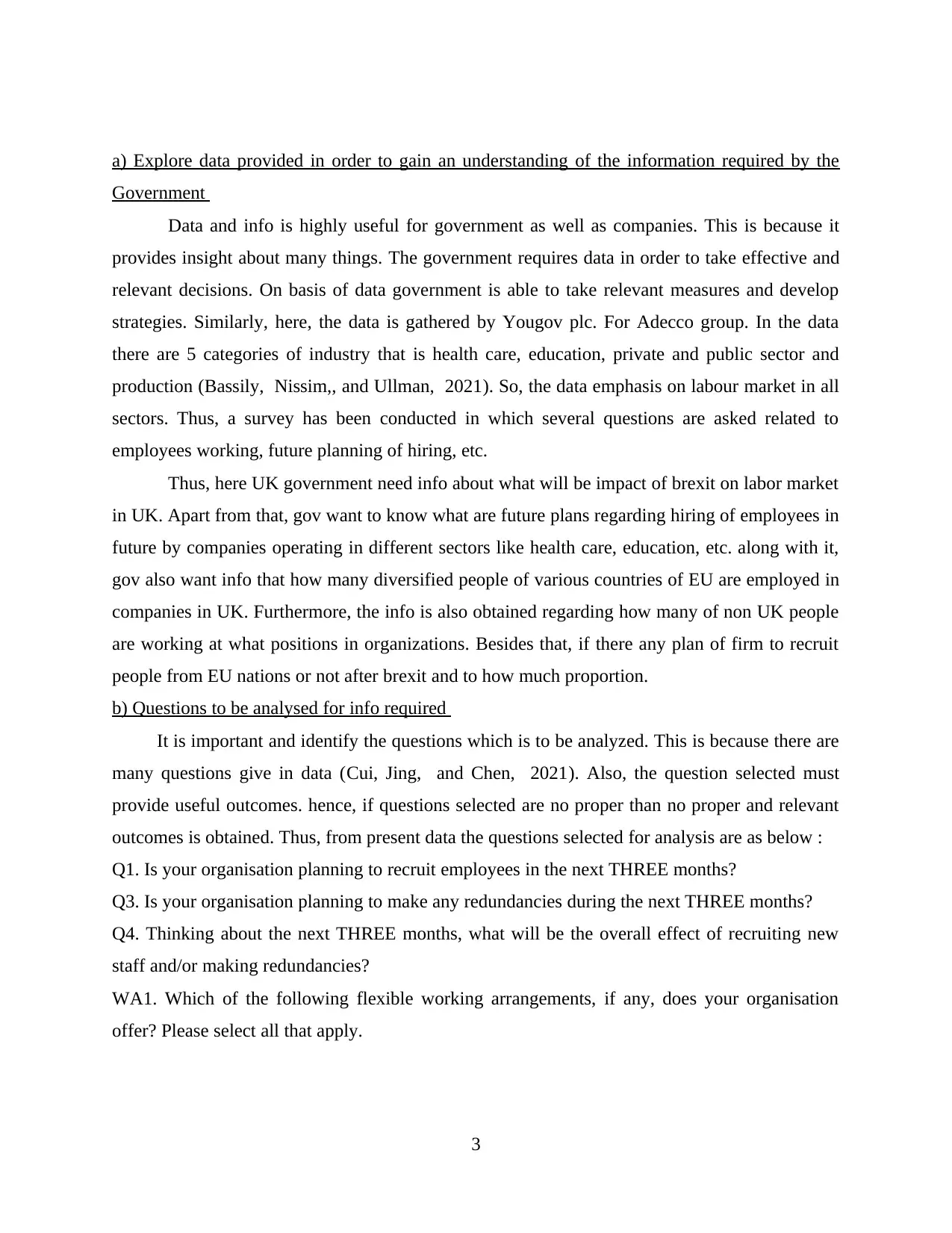
a) Explore data provided in order to gain an understanding of the information required by the
Government
Data and info is highly useful for government as well as companies. This is because it
provides insight about many things. The government requires data in order to take effective and
relevant decisions. On basis of data government is able to take relevant measures and develop
strategies. Similarly, here, the data is gathered by Yougov plc. For Adecco group. In the data
there are 5 categories of industry that is health care, education, private and public sector and
production (Bassily, Nissim,, and Ullman, 2021). So, the data emphasis on labour market in all
sectors. Thus, a survey has been conducted in which several questions are asked related to
employees working, future planning of hiring, etc.
Thus, here UK government need info about what will be impact of brexit on labor market
in UK. Apart from that, gov want to know what are future plans regarding hiring of employees in
future by companies operating in different sectors like health care, education, etc. along with it,
gov also want info that how many diversified people of various countries of EU are employed in
companies in UK. Furthermore, the info is also obtained regarding how many of non UK people
are working at what positions in organizations. Besides that, if there any plan of firm to recruit
people from EU nations or not after brexit and to how much proportion.
b) Questions to be analysed for info required
It is important and identify the questions which is to be analyzed. This is because there are
many questions give in data (Cui, Jing, and Chen, 2021). Also, the question selected must
provide useful outcomes. hence, if questions selected are no proper than no proper and relevant
outcomes is obtained. Thus, from present data the questions selected for analysis are as below :
Q1. Is your organisation planning to recruit employees in the next THREE months?
Q3. Is your organisation planning to make any redundancies during the next THREE months?
Q4. Thinking about the next THREE months, what will be the overall effect of recruiting new
staff and/or making redundancies?
WA1. Which of the following flexible working arrangements, if any, does your organisation
offer? Please select all that apply.
3
Government
Data and info is highly useful for government as well as companies. This is because it
provides insight about many things. The government requires data in order to take effective and
relevant decisions. On basis of data government is able to take relevant measures and develop
strategies. Similarly, here, the data is gathered by Yougov plc. For Adecco group. In the data
there are 5 categories of industry that is health care, education, private and public sector and
production (Bassily, Nissim,, and Ullman, 2021). So, the data emphasis on labour market in all
sectors. Thus, a survey has been conducted in which several questions are asked related to
employees working, future planning of hiring, etc.
Thus, here UK government need info about what will be impact of brexit on labor market
in UK. Apart from that, gov want to know what are future plans regarding hiring of employees in
future by companies operating in different sectors like health care, education, etc. along with it,
gov also want info that how many diversified people of various countries of EU are employed in
companies in UK. Furthermore, the info is also obtained regarding how many of non UK people
are working at what positions in organizations. Besides that, if there any plan of firm to recruit
people from EU nations or not after brexit and to how much proportion.
b) Questions to be analysed for info required
It is important and identify the questions which is to be analyzed. This is because there are
many questions give in data (Cui, Jing, and Chen, 2021). Also, the question selected must
provide useful outcomes. hence, if questions selected are no proper than no proper and relevant
outcomes is obtained. Thus, from present data the questions selected for analysis are as below :
Q1. Is your organisation planning to recruit employees in the next THREE months?
Q3. Is your organisation planning to make any redundancies during the next THREE months?
Q4. Thinking about the next THREE months, what will be the overall effect of recruiting new
staff and/or making redundancies?
WA1. Which of the following flexible working arrangements, if any, does your organisation
offer? Please select all that apply.
3
⊘ This is a preview!⊘
Do you want full access?
Subscribe today to unlock all pages.

Trusted by 1+ million students worldwide
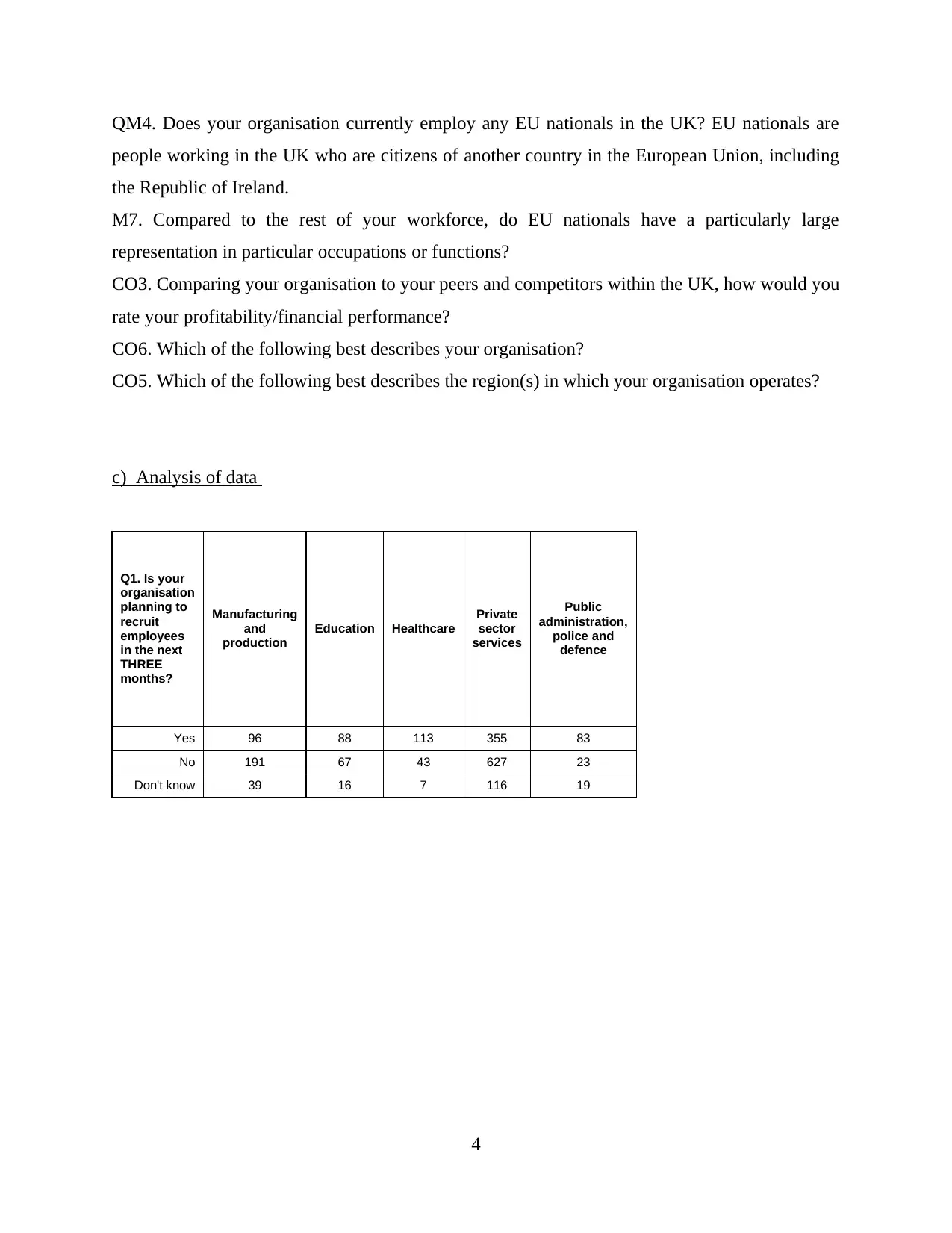
QM4. Does your organisation currently employ any EU nationals in the UK? EU nationals are
people working in the UK who are citizens of another country in the European Union, including
the Republic of Ireland.
M7. Compared to the rest of your workforce, do EU nationals have a particularly large
representation in particular occupations or functions?
CO3. Comparing your organisation to your peers and competitors within the UK, how would you
rate your profitability/financial performance?
CO6. Which of the following best describes your organisation?
CO5. Which of the following best describes the region(s) in which your organisation operates?
c) Analysis of data
Q1. Is your
organisation
planning to
recruit
employees
in the next
THREE
months?
Manufacturing
and
production
Education Healthcare
Private
sector
services
Public
administration,
police and
defence
Yes 96 88 113 355 83
No 191 67 43 627 23
Don't know 39 16 7 116 19
4
people working in the UK who are citizens of another country in the European Union, including
the Republic of Ireland.
M7. Compared to the rest of your workforce, do EU nationals have a particularly large
representation in particular occupations or functions?
CO3. Comparing your organisation to your peers and competitors within the UK, how would you
rate your profitability/financial performance?
CO6. Which of the following best describes your organisation?
CO5. Which of the following best describes the region(s) in which your organisation operates?
c) Analysis of data
Q1. Is your
organisation
planning to
recruit
employees
in the next
THREE
months?
Manufacturing
and
production
Education Healthcare
Private
sector
services
Public
administration,
police and
defence
Yes 96 88 113 355 83
No 191 67 43 627 23
Don't know 39 16 7 116 19
4
Paraphrase This Document
Need a fresh take? Get an instant paraphrase of this document with our AI Paraphraser
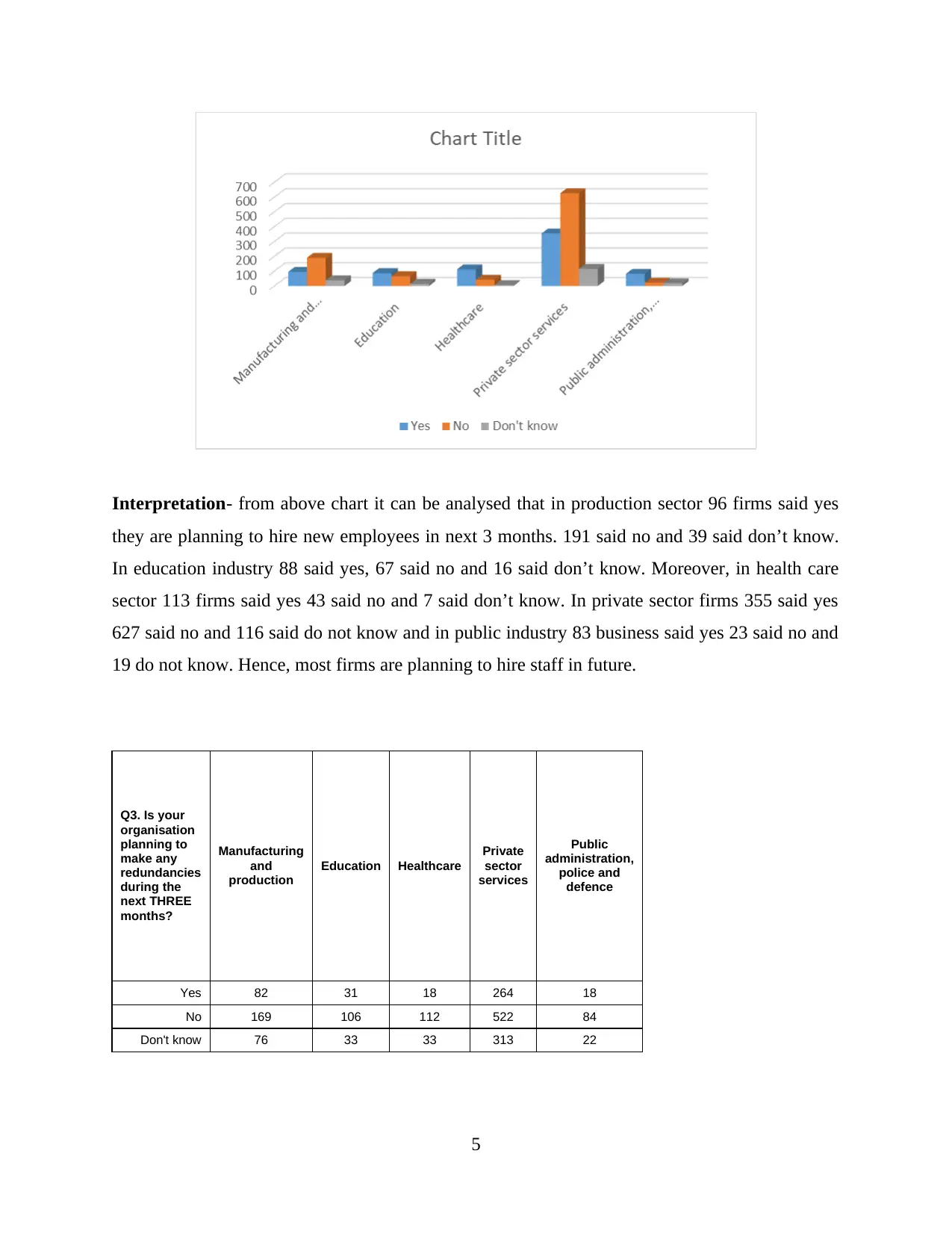
Interpretation- from above chart it can be analysed that in production sector 96 firms said yes
they are planning to hire new employees in next 3 months. 191 said no and 39 said don’t know.
In education industry 88 said yes, 67 said no and 16 said don’t know. Moreover, in health care
sector 113 firms said yes 43 said no and 7 said don’t know. In private sector firms 355 said yes
627 said no and 116 said do not know and in public industry 83 business said yes 23 said no and
19 do not know. Hence, most firms are planning to hire staff in future.
Q3. Is your
organisation
planning to
make any
redundancies
during the
next THREE
months?
Manufacturing
and
production
Education Healthcare
Private
sector
services
Public
administration,
police and
defence
Yes 82 31 18 264 18
No 169 106 112 522 84
Don't know 76 33 33 313 22
5
they are planning to hire new employees in next 3 months. 191 said no and 39 said don’t know.
In education industry 88 said yes, 67 said no and 16 said don’t know. Moreover, in health care
sector 113 firms said yes 43 said no and 7 said don’t know. In private sector firms 355 said yes
627 said no and 116 said do not know and in public industry 83 business said yes 23 said no and
19 do not know. Hence, most firms are planning to hire staff in future.
Q3. Is your
organisation
planning to
make any
redundancies
during the
next THREE
months?
Manufacturing
and
production
Education Healthcare
Private
sector
services
Public
administration,
police and
defence
Yes 82 31 18 264 18
No 169 106 112 522 84
Don't know 76 33 33 313 22
5
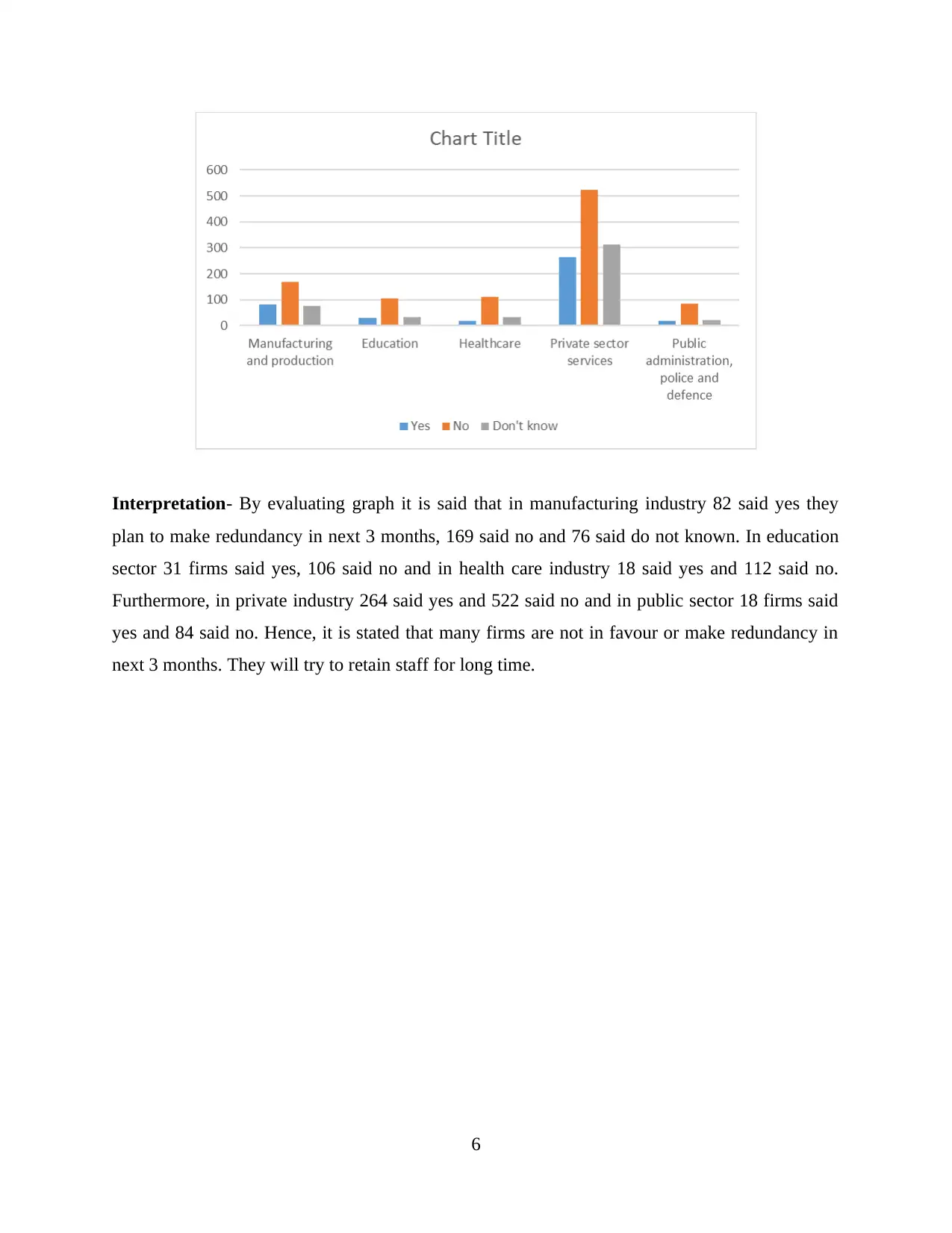
Interpretation- By evaluating graph it is said that in manufacturing industry 82 said yes they
plan to make redundancy in next 3 months, 169 said no and 76 said do not known. In education
sector 31 firms said yes, 106 said no and in health care industry 18 said yes and 112 said no.
Furthermore, in private industry 264 said yes and 522 said no and in public sector 18 firms said
yes and 84 said no. Hence, it is stated that many firms are not in favour or make redundancy in
next 3 months. They will try to retain staff for long time.
6
plan to make redundancy in next 3 months, 169 said no and 76 said do not known. In education
sector 31 firms said yes, 106 said no and in health care industry 18 said yes and 112 said no.
Furthermore, in private industry 264 said yes and 522 said no and in public sector 18 firms said
yes and 84 said no. Hence, it is stated that many firms are not in favour or make redundancy in
next 3 months. They will try to retain staff for long time.
6
⊘ This is a preview!⊘
Do you want full access?
Subscribe today to unlock all pages.

Trusted by 1+ million students worldwide
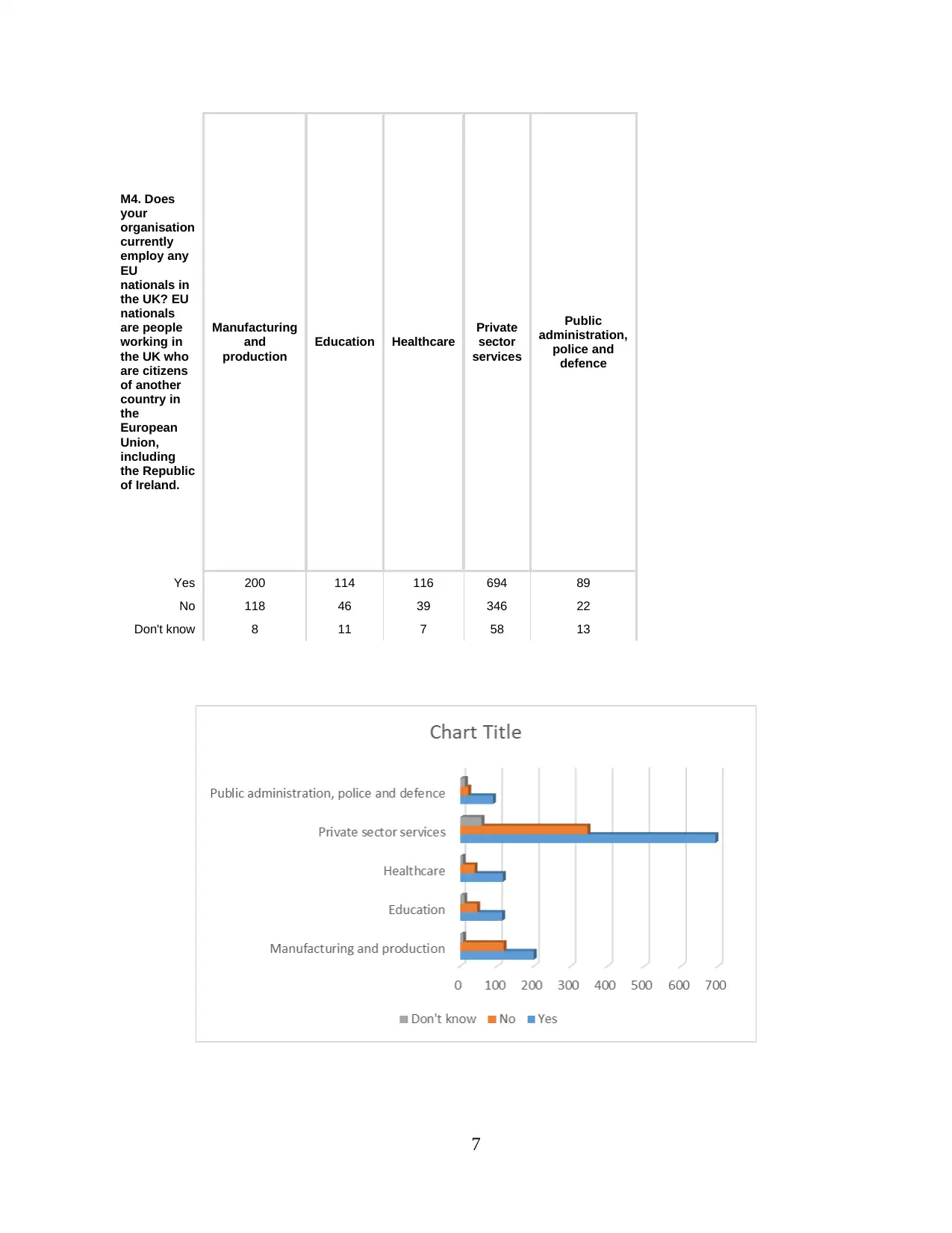
M4. Does
your
organisation
currently
employ any
EU
nationals in
the UK? EU
nationals
are people
working in
the UK who
are citizens
of another
country in
the
European
Union,
including
the Republic
of Ireland.
Manufacturing
and
production
Education Healthcare
Private
sector
services
Public
administration,
police and
defence
Yes 200 114 116 694 89
No 118 46 39 346 22
Don't know 8 11 7 58 13
7
your
organisation
currently
employ any
EU
nationals in
the UK? EU
nationals
are people
working in
the UK who
are citizens
of another
country in
the
European
Union,
including
the Republic
of Ireland.
Manufacturing
and
production
Education Healthcare
Private
sector
services
Public
administration,
police and
defence
Yes 200 114 116 694 89
No 118 46 39 346 22
Don't know 8 11 7 58 13
7
Paraphrase This Document
Need a fresh take? Get an instant paraphrase of this document with our AI Paraphraser
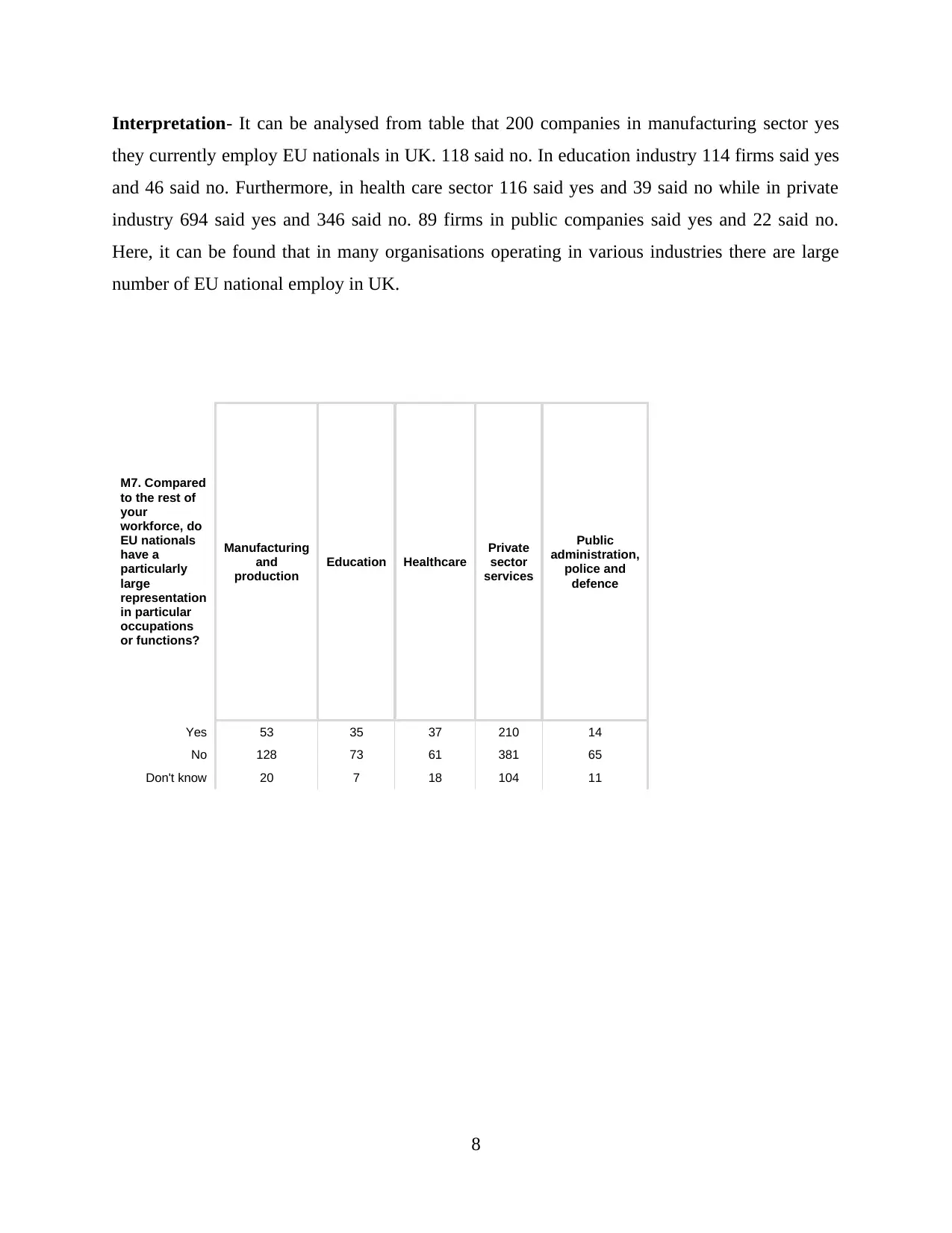
Interpretation- It can be analysed from table that 200 companies in manufacturing sector yes
they currently employ EU nationals in UK. 118 said no. In education industry 114 firms said yes
and 46 said no. Furthermore, in health care sector 116 said yes and 39 said no while in private
industry 694 said yes and 346 said no. 89 firms in public companies said yes and 22 said no.
Here, it can be found that in many organisations operating in various industries there are large
number of EU national employ in UK.
M7. Compared
to the rest of
your
workforce, do
EU nationals
have a
particularly
large
representation
in particular
occupations
or functions?
Manufacturing
and
production
Education Healthcare
Private
sector
services
Public
administration,
police and
defence
Yes 53 35 37 210 14
No 128 73 61 381 65
Don't know 20 7 18 104 11
8
they currently employ EU nationals in UK. 118 said no. In education industry 114 firms said yes
and 46 said no. Furthermore, in health care sector 116 said yes and 39 said no while in private
industry 694 said yes and 346 said no. 89 firms in public companies said yes and 22 said no.
Here, it can be found that in many organisations operating in various industries there are large
number of EU national employ in UK.
M7. Compared
to the rest of
your
workforce, do
EU nationals
have a
particularly
large
representation
in particular
occupations
or functions?
Manufacturing
and
production
Education Healthcare
Private
sector
services
Public
administration,
police and
defence
Yes 53 35 37 210 14
No 128 73 61 381 65
Don't know 20 7 18 104 11
8
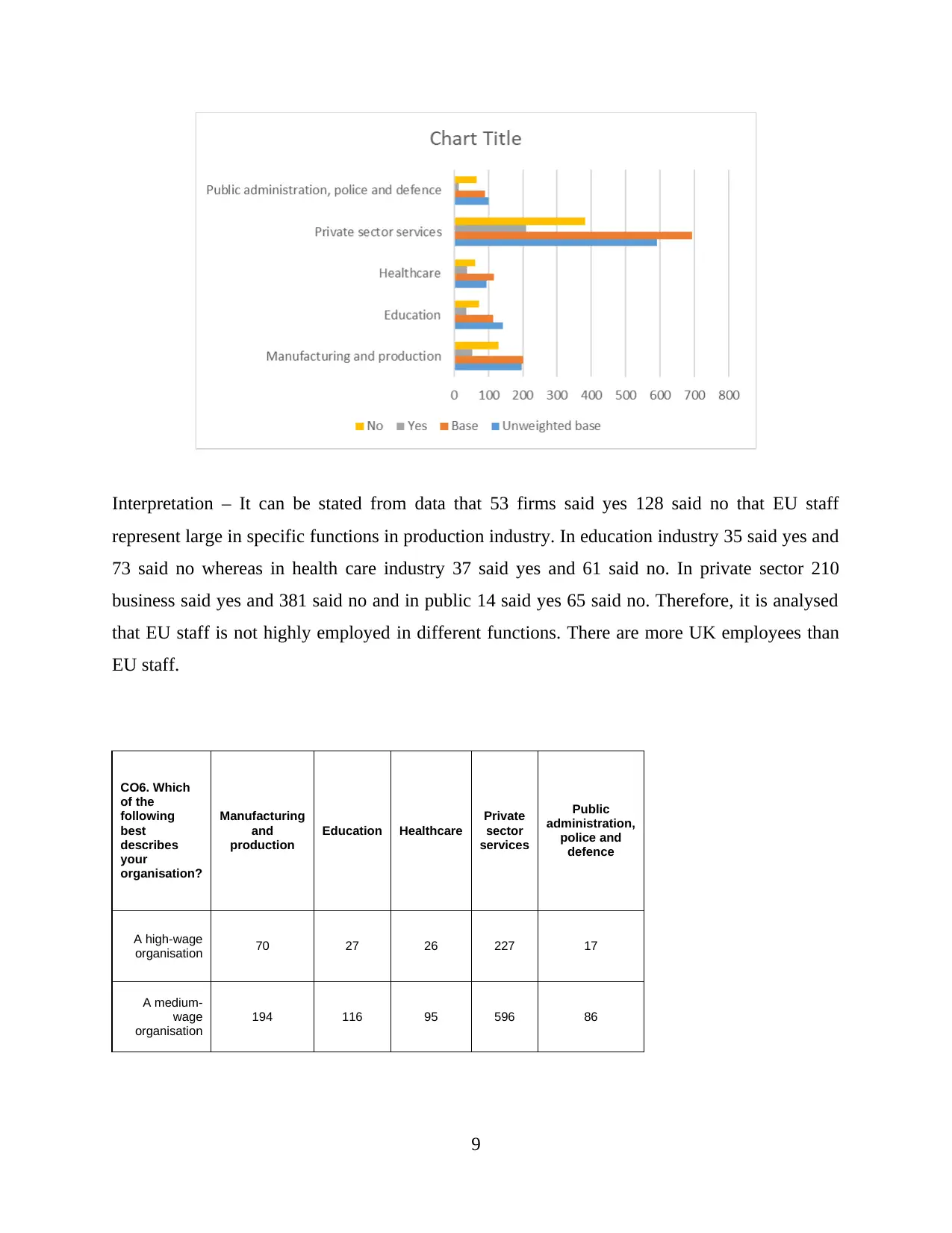
Interpretation – It can be stated from data that 53 firms said yes 128 said no that EU staff
represent large in specific functions in production industry. In education industry 35 said yes and
73 said no whereas in health care industry 37 said yes and 61 said no. In private sector 210
business said yes and 381 said no and in public 14 said yes 65 said no. Therefore, it is analysed
that EU staff is not highly employed in different functions. There are more UK employees than
EU staff.
CO6. Which
of the
following
best
describes
your
organisation?
Manufacturing
and
production
Education Healthcare
Private
sector
services
Public
administration,
police and
defence
A high-wage
organisation 70 27 26 227 17
A medium-
wage
organisation
194 116 95 596 86
9
represent large in specific functions in production industry. In education industry 35 said yes and
73 said no whereas in health care industry 37 said yes and 61 said no. In private sector 210
business said yes and 381 said no and in public 14 said yes 65 said no. Therefore, it is analysed
that EU staff is not highly employed in different functions. There are more UK employees than
EU staff.
CO6. Which
of the
following
best
describes
your
organisation?
Manufacturing
and
production
Education Healthcare
Private
sector
services
Public
administration,
police and
defence
A high-wage
organisation 70 27 26 227 17
A medium-
wage
organisation
194 116 95 596 86
9
⊘ This is a preview!⊘
Do you want full access?
Subscribe today to unlock all pages.

Trusted by 1+ million students worldwide
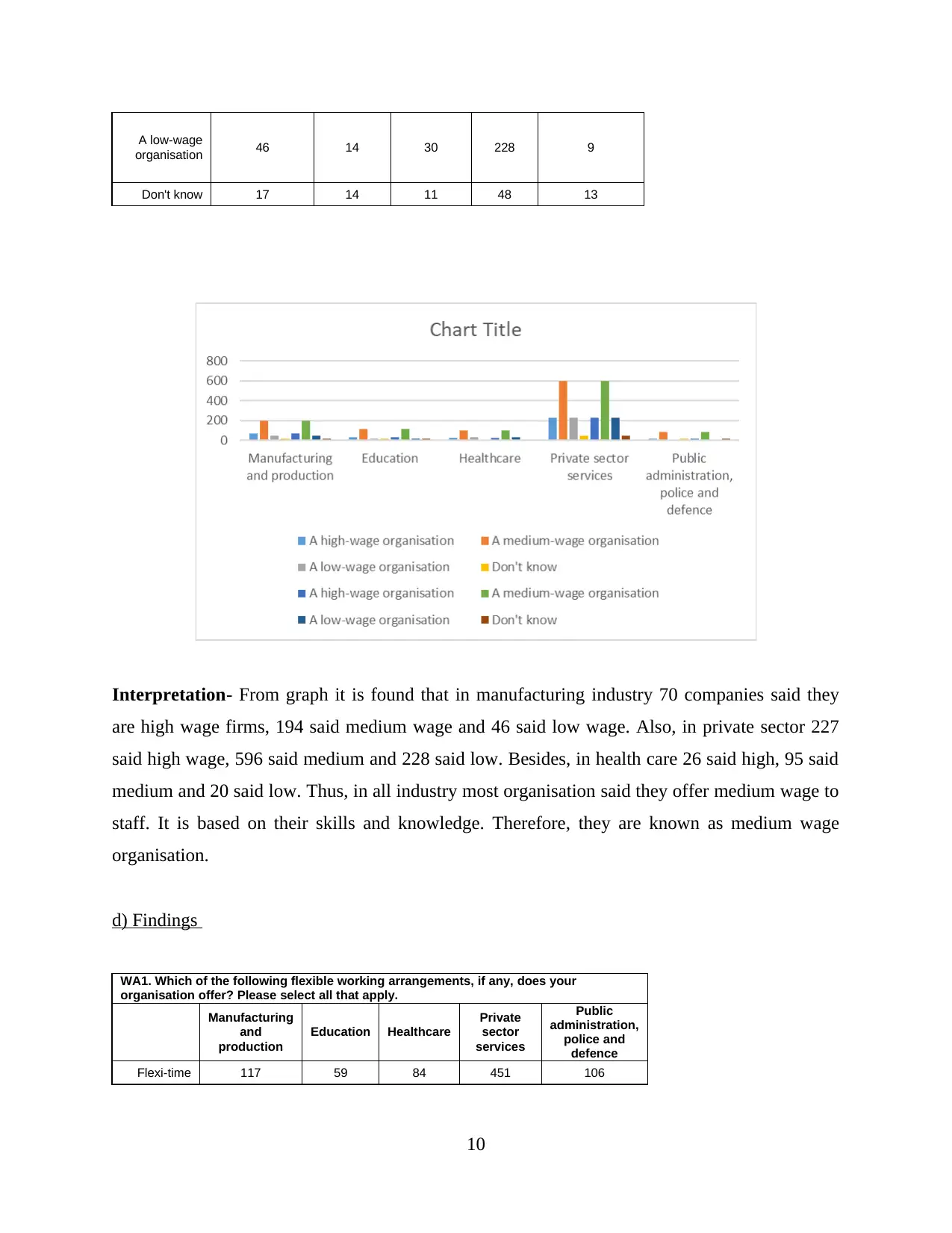
A low-wage
organisation 46 14 30 228 9
Don't know 17 14 11 48 13
Interpretation- From graph it is found that in manufacturing industry 70 companies said they
are high wage firms, 194 said medium wage and 46 said low wage. Also, in private sector 227
said high wage, 596 said medium and 228 said low. Besides, in health care 26 said high, 95 said
medium and 20 said low. Thus, in all industry most organisation said they offer medium wage to
staff. It is based on their skills and knowledge. Therefore, they are known as medium wage
organisation.
d) Findings
WA1. Which of the following flexible working arrangements, if any, does your
organisation offer? Please select all that apply.
Manufacturing
and
production
Education Healthcare
Private
sector
services
Public
administration,
police and
defence
Flexi-time 117 59 84 451 106
10
organisation 46 14 30 228 9
Don't know 17 14 11 48 13
Interpretation- From graph it is found that in manufacturing industry 70 companies said they
are high wage firms, 194 said medium wage and 46 said low wage. Also, in private sector 227
said high wage, 596 said medium and 228 said low. Besides, in health care 26 said high, 95 said
medium and 20 said low. Thus, in all industry most organisation said they offer medium wage to
staff. It is based on their skills and knowledge. Therefore, they are known as medium wage
organisation.
d) Findings
WA1. Which of the following flexible working arrangements, if any, does your
organisation offer? Please select all that apply.
Manufacturing
and
production
Education Healthcare
Private
sector
services
Public
administration,
police and
defence
Flexi-time 117 59 84 451 106
10
Paraphrase This Document
Need a fresh take? Get an instant paraphrase of this document with our AI Paraphraser
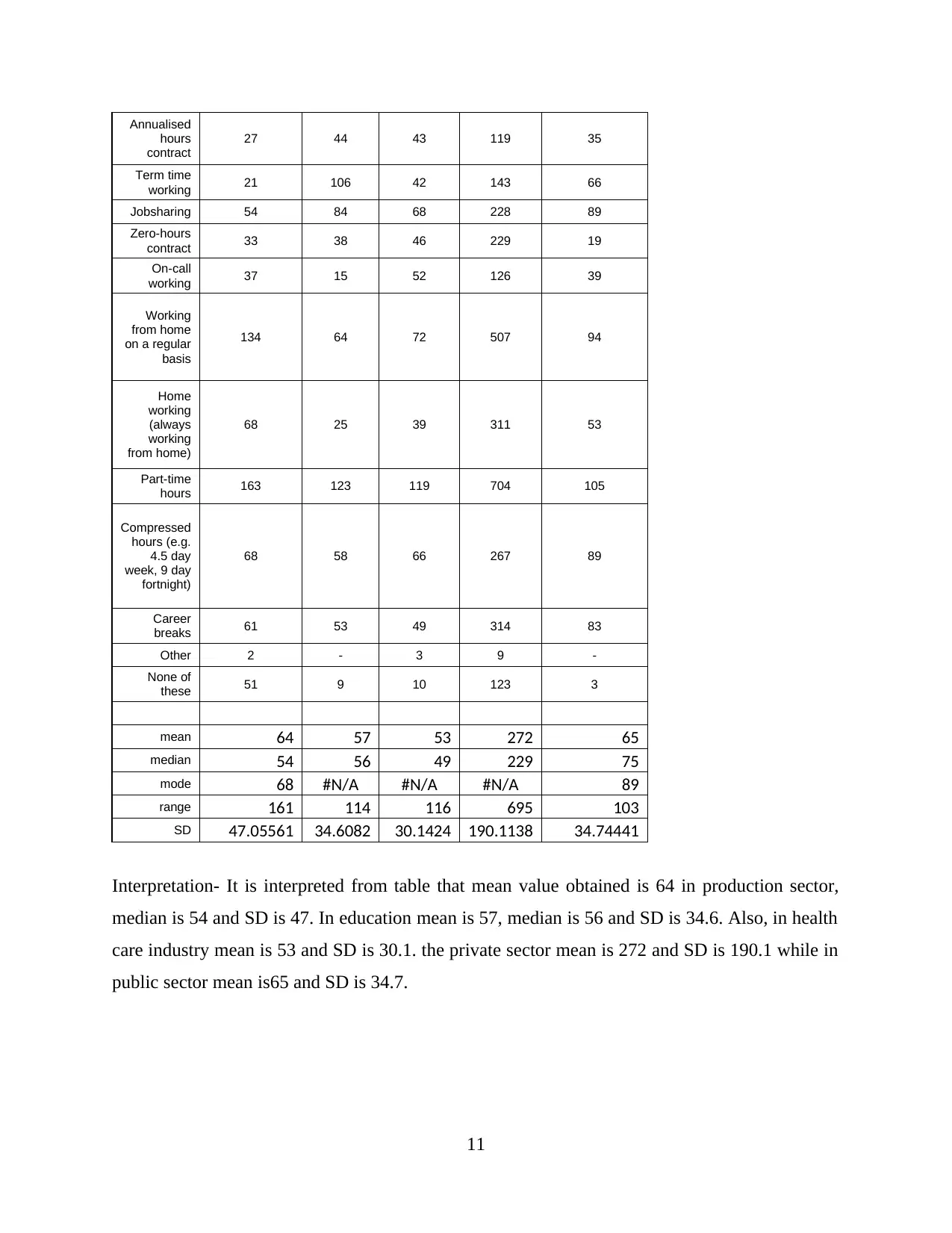
Annualised
hours
contract
27 44 43 119 35
Term time
working 21 106 42 143 66
Jobsharing 54 84 68 228 89
Zero-hours
contract 33 38 46 229 19
On-call
working 37 15 52 126 39
Working
from home
on a regular
basis
134 64 72 507 94
Home
working
(always
working
from home)
68 25 39 311 53
Part-time
hours 163 123 119 704 105
Compressed
hours (e.g.
4.5 day
week, 9 day
fortnight)
68 58 66 267 89
Career
breaks 61 53 49 314 83
Other 2 - 3 9 -
None of
these 51 9 10 123 3
mean 64 57 53 272 65
median 54 56 49 229 75
mode 68 #N/A #N/A #N/A 89
range 161 114 116 695 103
SD 47.05561 34.6082 30.1424 190.1138 34.74441
Interpretation- It is interpreted from table that mean value obtained is 64 in production sector,
median is 54 and SD is 47. In education mean is 57, median is 56 and SD is 34.6. Also, in health
care industry mean is 53 and SD is 30.1. the private sector mean is 272 and SD is 190.1 while in
public sector mean is65 and SD is 34.7.
11
hours
contract
27 44 43 119 35
Term time
working 21 106 42 143 66
Jobsharing 54 84 68 228 89
Zero-hours
contract 33 38 46 229 19
On-call
working 37 15 52 126 39
Working
from home
on a regular
basis
134 64 72 507 94
Home
working
(always
working
from home)
68 25 39 311 53
Part-time
hours 163 123 119 704 105
Compressed
hours (e.g.
4.5 day
week, 9 day
fortnight)
68 58 66 267 89
Career
breaks 61 53 49 314 83
Other 2 - 3 9 -
None of
these 51 9 10 123 3
mean 64 57 53 272 65
median 54 56 49 229 75
mode 68 #N/A #N/A #N/A 89
range 161 114 116 695 103
SD 47.05561 34.6082 30.1424 190.1138 34.74441
Interpretation- It is interpreted from table that mean value obtained is 64 in production sector,
median is 54 and SD is 47. In education mean is 57, median is 56 and SD is 34.6. Also, in health
care industry mean is 53 and SD is 30.1. the private sector mean is 272 and SD is 190.1 while in
public sector mean is65 and SD is 34.7.
11
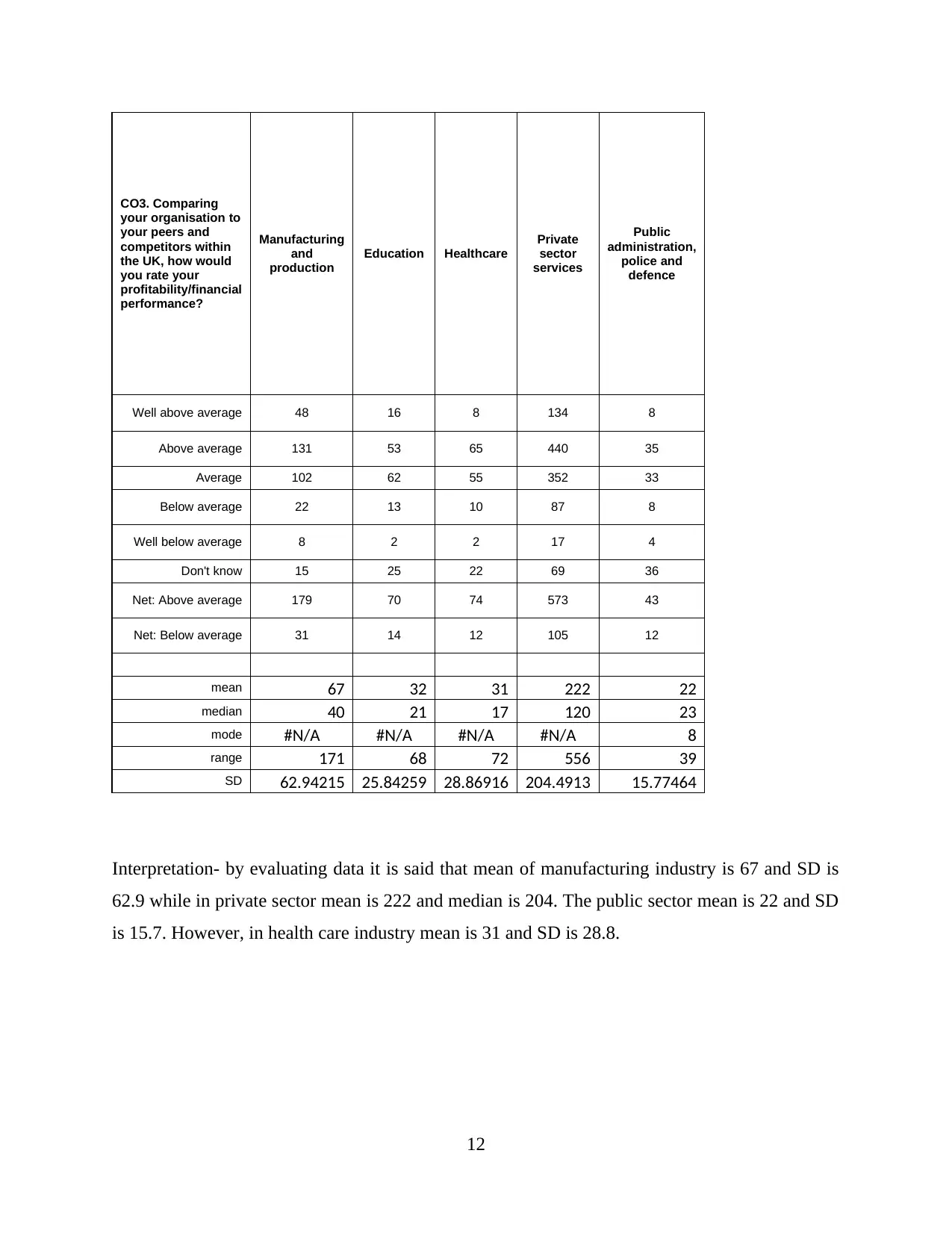
CO3. Comparing
your organisation to
your peers and
competitors within
the UK, how would
you rate your
profitability/financial
performance?
Manufacturing
and
production
Education Healthcare
Private
sector
services
Public
administration,
police and
defence
Well above average 48 16 8 134 8
Above average 131 53 65 440 35
Average 102 62 55 352 33
Below average 22 13 10 87 8
Well below average 8 2 2 17 4
Don't know 15 25 22 69 36
Net: Above average 179 70 74 573 43
Net: Below average 31 14 12 105 12
mean 67 32 31 222 22
median 40 21 17 120 23
mode #N/A #N/A #N/A #N/A 8
range 171 68 72 556 39
SD 62.94215 25.84259 28.86916 204.4913 15.77464
Interpretation- by evaluating data it is said that mean of manufacturing industry is 67 and SD is
62.9 while in private sector mean is 222 and median is 204. The public sector mean is 22 and SD
is 15.7. However, in health care industry mean is 31 and SD is 28.8.
12
your organisation to
your peers and
competitors within
the UK, how would
you rate your
profitability/financial
performance?
Manufacturing
and
production
Education Healthcare
Private
sector
services
Public
administration,
police and
defence
Well above average 48 16 8 134 8
Above average 131 53 65 440 35
Average 102 62 55 352 33
Below average 22 13 10 87 8
Well below average 8 2 2 17 4
Don't know 15 25 22 69 36
Net: Above average 179 70 74 573 43
Net: Below average 31 14 12 105 12
mean 67 32 31 222 22
median 40 21 17 120 23
mode #N/A #N/A #N/A #N/A 8
range 171 68 72 556 39
SD 62.94215 25.84259 28.86916 204.4913 15.77464
Interpretation- by evaluating data it is said that mean of manufacturing industry is 67 and SD is
62.9 while in private sector mean is 222 and median is 204. The public sector mean is 22 and SD
is 15.7. However, in health care industry mean is 31 and SD is 28.8.
12
⊘ This is a preview!⊘
Do you want full access?
Subscribe today to unlock all pages.

Trusted by 1+ million students worldwide
1 out of 17
Related Documents
Your All-in-One AI-Powered Toolkit for Academic Success.
+13062052269
info@desklib.com
Available 24*7 on WhatsApp / Email
![[object Object]](/_next/static/media/star-bottom.7253800d.svg)
Unlock your academic potential
Copyright © 2020–2025 A2Z Services. All Rights Reserved. Developed and managed by ZUCOL.





